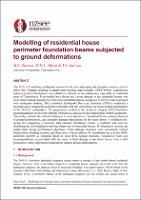Modelling of residential house perimeter foundation beams subjected to ground deformations

Download
Date
2023-04-19Authors
Dawson, Max
Sullivan, Timothy
Millen, Maxim
Metadata
Show full item recordAbstract
The 2010-11 Canterbury earthquake sequence is the most damaging and disruptive seismic event to affect New Zealand, resulting in repair costs totalling approximately NZ$40 billion. Liquefaction induced ground deformations was a distinctive feature in the earthquakes, especially in residential areas of Christchurch. Prior studies have shown that severe damage to the residential houses was more often related to liquefaction induced ground deformation, as opposed to inertial loads associated with earthquake shaking. The Canterbury Earthquake Recovery Authority (CERA) conducted a reconnaissance programme to divide residential land into zones based on observed land performance in the 2010-11 earthquakes. The programme resulted in the technical category (TC) foundation recommendations given in the Ministry of Business, Innovation and Employment (MBIE) guidelines. This study evaluates the inelastic behaviour of several perimeter foundation beam sections subjected to ground deformations and considers damage implications for the house above. A nonlinear soil-spring bed supporting a nonlinear fibre-element foundation section is validated and used for simulating the soil-foundation interface behaviour of residential houses. TC foundation sections are tested under design performance objectives. Three damage measures were considered: vertical displacement, bending moment, and shear force. Results indicate TC foundations given in the MBIE guidelines perform as expected, based on these three damage measures. Foundation beam size recommendations are provided with the intent to limit damage in the house above, from a drift perspective, when subjected to liquefaction induced ground deformations.
